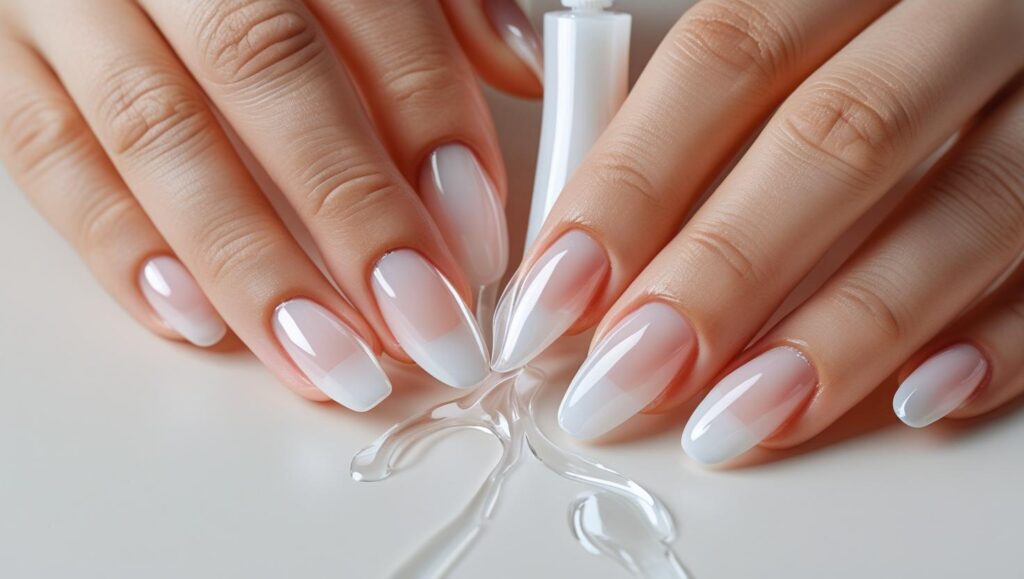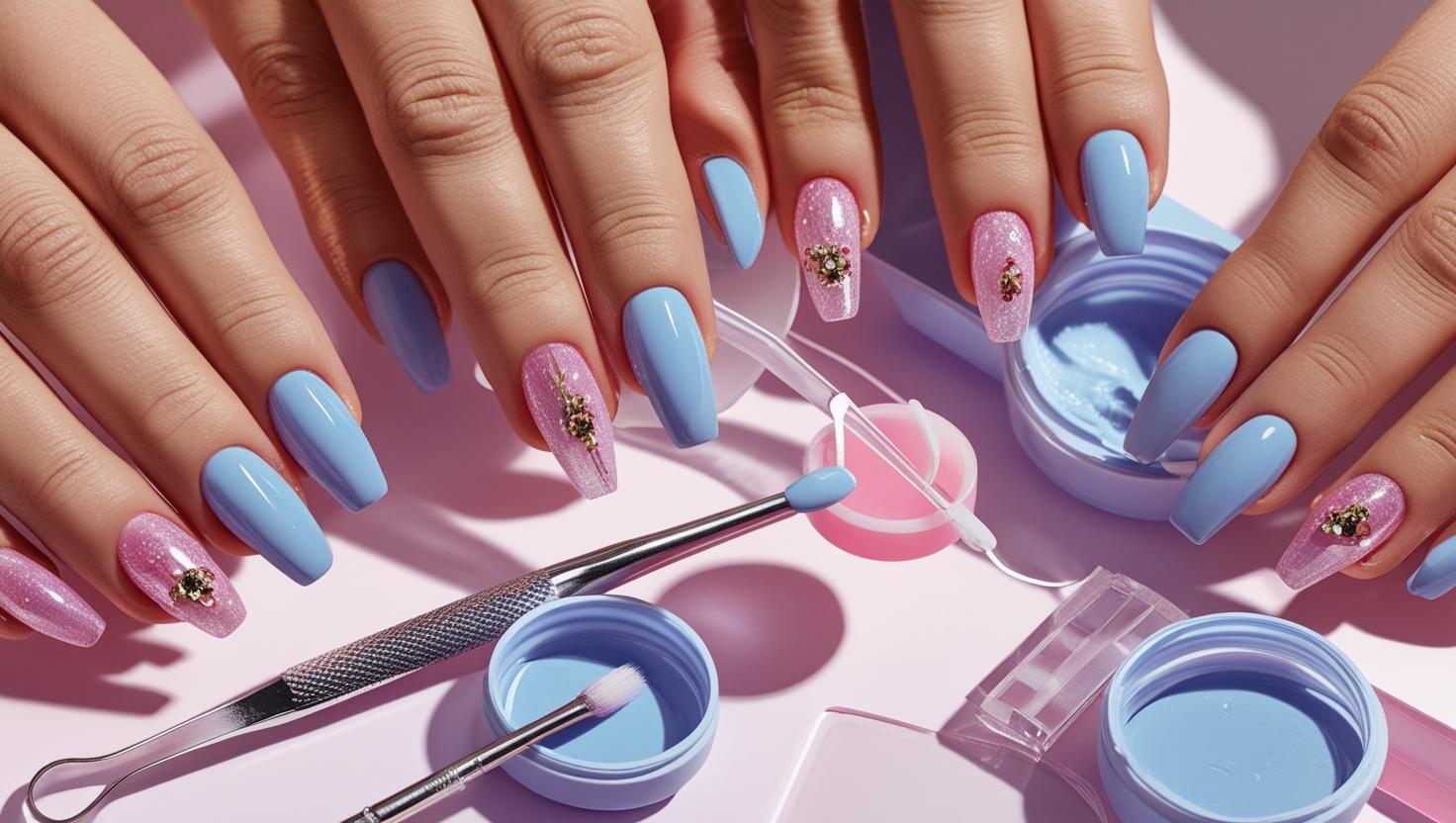Glue on Acrylics – Achieving Lasting and Flawless Results
Attaching acrylic nails with glue seems simple, but perfection demands precision. Whether you’re new to nail enhancements or aiming to optimize longevity with minimal effort, this guide illuminates lesser-known strategies and expert secrets.

Understanding Glue and Acrylic Compatibility
Chemical Bond vs. Surface Adhesion
Acrylic forms via a polymerization reaction. Glue, however, bonds superficially. The strongest adhesion occurs when your acrylic nail’s surface features micro-roughness or subtle scratches. Lightly buffing helps create an ideal canvas for the adhesive to latch onto.
Different Glue Types and Why They Matter
- Latex-free cyanoacrylate: stiffer set, ideal for long tips
- Odorless gel glue: softer grip, great for beginners
- Dual-bond glue with activator: boosts hold on slippery acrylic surfaces
Choosing the correct type prevents lifting and minimizes allergic reactions.
Surface Prep – The Foundation of Durability
Cleaning and Degreasing
Even freshly cured acrylic retains residue. Use 99% isopropyl alcohol between fingers and nail plate to eliminate oils. Skip standard nail polish remover — its acetone content can weaken adhesives.
Light Buffing Technique
Use a 220-grit buffer to gently scuff surfaces, working in small circles. This method preserves structure while improving adhesion.
Proper Drying Before Glue
After alcohol prep, air-dry ten seconds or lightly blow. Residual moisture negates bonding strength, causing early failure.
Application Precision – Glue on Acrylics Without Smudging
Strategic Drops
Use one drop of glue at the nail’s center and two near the sides. Excess glue forces spillover; too little causes bubbles.
Tip Alignment
Apply tip with a single, straight press—don’t wiggle. A proper bond sets in seconds; repositioning causes stress cracks.
Set Duration
Hold for 10 seconds, then wait another 30 before proceeding to filing or shaping. Early filing weakens the bond.
Troubleshooting Lifting and Peeling
Detecting Early Lifts
If a corner rises within two days, hydrate the nail plate. Sometimes natural oil breaks the seal. Lightly buff the area, apply alcohol, and add a minimal bead of glue.
Bubbles or White Spots
Trapped air during glue application causes occlusion. Press firmly to push out air, wipe off excess, and cure thoroughly.
Allergen Awareness
Redness or itch near the cuticle signals glue sensitivity. Transition to formaldehyde-free or ethyl-based adhesives, and see a dermatologist if symptoms persist.
Enhancing Longevity
Use a Primer Layer
Apply a bonding primer before adhesion. It improves hold, especially when using dual-bond systems with activators.
Nail Oil Aftercare
Post-application, massage cuticle oil daily. This calibrates flexibility between natural and acrylic nails while preventing glue burs.
Protect from Water and Heat
Frequent hot showers or dishwashing can cause early lift. Always wear gloves during chores.
Unique Tips You Won’t Find Everywhere
-
Tea Bag Reinforcement
Cut a small square of tea bag paper and glue it onto stress-prone areas. It spreads tension and reduces breakage. -
Glue Sandwich Method
After tip application, lightly emery the edges, clean, then apply a second, thinner glue layer before buffing out. It locks the tip more securely. -
Microwave Activation Trick
Slightly warm a drop of glue (5-second microwave zaps) for fast cure and better penetration. Only viable with microwave-safe containers and careful temperature control. -
Cold-Weather Adaptation
Cooler ambient air slows bonding. Warm your hands under hot water for 30 seconds before application for optimal cure and versatility.
Safety and Removal Best Practices
Gentle Soak-Off Method
Use acetone diluted 70% to float off tips faster than pure acetone. Avoid scraping with metal tools to preserve nail health.
Dispose of Glue Safely
Keep your glue container sealed upright. Store away from heat or sunlight. Discard after six months to prevent hardening or volatility.
Allergy Mitigation
Switch glue brands or take 48-hour breaks between sets to reduce the risk of sensitization. Rotate adhesives if you use acrylic nails frequently.
FAQs
Can I use regular super glue on acrylic nails?
No. Regular super glue contains additives that can discolor your nails, irritate the skin, or prematurely degrade acrylic.
How long do professional salon acrylic tips last with glue?
With optimal technique, tips last up to 3 weeks before needing fill or reapplication.
Does nail glue weaken after opening?
Yes. Glue gradually picks up moisture and hardens. Use within 3–6 months and keep sealed to maximize effectiveness.
Why did my glue turn white under acrylic?
White glue indicates micro-air pockets or moisture trapped during application. Buff, clean, reapply, and massage to prevent recurrence.
Can I use LED or UV light to cure glue on acrylics?
No. Nail glue uses cyanoacrylate chemistry; LED or UV lamps won’t accelerate curing and may cause surface discoloration.
Conclusion
Applying glue on acrylic nails is more than a quick fix—it’s a craft that balances chemistry, technique, and thoughtful aftercare. Follow these pro tips—from surface prep to troubleshooting—to enhance durability, avoid lifting, and protect nail integrity. Remember: small refinements, like tea bag reinforcement or microwave drops, make all the difference. Nail your look with confidence!


Leave a Reply to Dashes Pop-On Nails This Christmas: The Ultimate Guide to Festive Glam Cancel reply